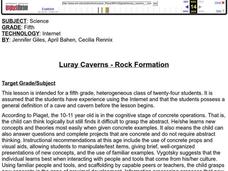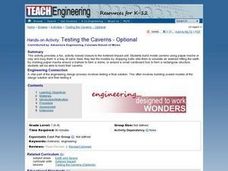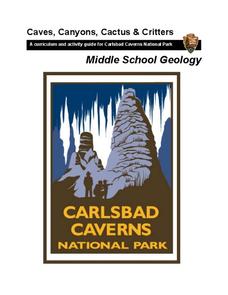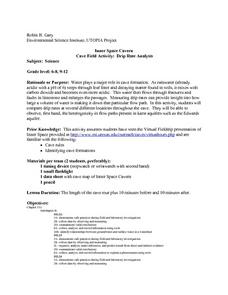Teach Engineering
Building and Testing Model Underground Safety Caverns
Teams take their cavern designs and build a model from clay or paper mache that can be buried in sand. Testing involves dropping a bowling ball on the buried cavern. Teams dig out their cavern, inspect it for damage, and consider...
Curated OER
Deep Inside a Cavern
Students describe how different types of caves and their physical features were formed. They distinguish between stalactites and stalagmites (stalactites grow down from the roof of a cave and stalagmites grow up from the floor)....
Teach Engineering
Ranking the Rocks for Desired Properties
Math rocks! Cavern design teams determine the rankings of rock types based upon desirability points. The points are connected to the properties of the rocks and their usefulness in building a cavern.
Curated OER
Luray Caverns - Rock Formation
Fifth graders conduct research on the geological formation Luray Caverns located in Luray, Virginia in preparation for a field trip to the caverns. They conduct Internet research, and answer worksheet discussion questions.
Teach Engineering
Recommendations and Presentations: Drum Roll Please
Teams analyze the data they collected during the past six lessons and finalize where they will build a survival cavern. They then present their decisions to the rest of the class and justify their locations.
New Mexico State University
Creature Caverns
Plot the relationship of characteristics of creepy creatures. Learners plot the coordinates to describe the number of eyes, horns, and/or brains different creatures have. Pupils fill out a table to plot the points and complete the...
Curated OER
Testing the Caverns
Students build model caverns using paper mache or clay and bury them in a tray of sand. They test the models by dropping balls onto them to simulate an asteroid hitting the earth. They evaluate the effectiveness of a structure against...
Teach Engineering
Identifying Possible Underground Cavern Locations
Teams continue with the Asteroid Impact challenge and determine possible locations to construct their underground shelters. Participants cut scale area models of their shelters from paper and place them on the map to find locations...
Teach Engineering
How Big? Necessary Area and Volume for Shelter
Teams must determine the size of cavern needed to house the citizens of Alabraska to protect them from the asteroid impact. Using scaling properties, teams first determining the number of people that could sleep in a classroom and then...
Teach Engineering
Rocks, Rocks, Rocks: Test, Identify Properties and Classify
Time is growing short. Teams work together to identify physical properties of rocks in order to determine the properties that would best suit their cavern shelter design.
Curated OER
Cavern Life
Young scholars describe elements and conditions that effect cavern life. They explain the three cavern zones and the differences of each zone. They perform various activities based on grade level.
Curated OER
TE Activity: Testing the Caverns
Middle schoolers make model caverns out of paper mache or clay. They bury them in a tray of sand, and test the models by dropping balls into them simulating as asteroid hitting the earth. They discuss the results of the activity in a...
Curated OER
Caverns: Types of speleothems
Students identify types of speleothems commonly found in limestone caverns. They perform various activities based on grade level.
Curated OER
Caverns: Drip Rate Analysis
Students tour a cave and collect water samples. They measure the drip rate from several locations inside the cave and discover the part water plays in cave formation.
National Park Service
Caves, Canyons, Cactus, and Critters
Mother Nature's Gravel Company is open for business! The unit includes four lessons covering weathering and erosion. Experiments are simple to complete and young geologists compare notes to see who makes the biggest ice...
K12 Reader
Stalagmite Stalactite
The difference between stalactites and stalagmites, and how both are formed, is the subject of a cross-curricular reading comprehension worksheet that asks kids to read the passage and then respond to comprehension questions based on the...
Curated OER
How Caves Are Formed
Students explore caves. In this cave formation lesson, students take a virtual tour of a cave and then participate in a scientific investigation that requires them to grow crystals and chart data regarding their growth.
Curated OER
Create a Cavern
Students make a classroom cave using chairs, desks, and sheets to create a meandering path. They explore safety steps for spelunking exploration.
Curated OER
Cavern Life: The Food Web
Students explain the importance of elements on a food web. They realize that without light there can be no life. They perform various activities based on grade level.
Curated OER
Cavern Geology: Speleothem Construction
Young scholars discover how underground rock formations grow. They perform various activities based on grade level.
Curated OER
Inner Space Cavern Cave Field Activity: Drip Rate Analysis
Students compare drip rates at several different locations throughout a cave. They observe, first hand, the heterogeneity in flow paths present in karst aquifers such as the Edwards aquifer.
Curated OER
Possible Locations
Students create maps with cutout pieces of paper that represent caverns. They develop a scale for their map and decide where the best location is to live. They discover the importance of map reading skills.
Curated OER
Where is Oil Found?
Students determine that crude oil is found in porous rocks (reservoirs) rather than in caves or caverns.
Curated OER
Scaling the Map
Students practice determining map distances using the map scales. They discover how much an area represents on the map in relation to the actual area. They decide on the best place to build their cavern.
Other popular searches
- Caves and Caverns
- Luray Caverns
- Lura Caverns
- Limestone Caverns
- Carlsbad Caverns
- Caves. Caverns
- Marianna Caverns
- Caves Caverns
- Laurel Caverns
- Caverns and Glaciers
- Gibbons Caves and Caverns
- Underground Caverns

























